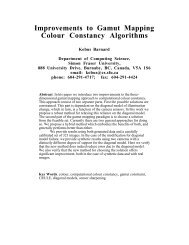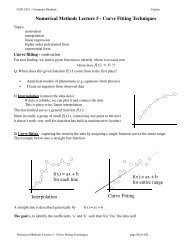1 Introduction
1 Introduction
1 Introduction
- No tags were found...
You also want an ePaper? Increase the reach of your titles
YUMPU automatically turns print PDFs into web optimized ePapers that Google loves.
1.5. Decision Theory 39the rest of the book. Further background, as well as more detailed accounts, can befound in Berger (1985) and Bather (2000).Before giving a more detailed analysis, let us first consider informally how wemight expect probabilities to play a role in making decisions. When we obtain theX-ray image x for a new patient, our goal is to decide which of the two classes toassign to the image. We are interested in the probabilities of the two classes giventhe image, which are given by p(C k |x). Using Bayes’ theorem, these probabilitiescan be expressed in the formp(C k |x) = p(x|C k)p(C k ). (1.77)p(x)Note that any of the quantities appearing in Bayes’ theorem can be obtained fromthe joint distribution p(x, C k ) by either marginalizing or conditioning with respect tothe appropriate variables. We can now interpret p(C k ) as the prior probability for theclass C k , and p(C k |x) as the corresponding posterior probability. Thus p(C 1 ) representsthe probability that a person has cancer, before we take the X-ray measurement.Similarly, p(C 1 |x) is the corresponding probability, revised using Bayes’ theorem inlight of the information contained in the X-ray. If our aim is to minimize the chanceof assigning x to the wrong class, then intuitively we would choose the class havingthe higher posterior probability. We now show that this intuition is correct, and wealso discuss more general criteria for making decisions.1.5.1 Minimizing the misclassification rateSuppose that our goal is simply to make as few misclassifications as possible.We need a rule that assigns each value of x to one of the available classes. Such arule will divide the input space into regions R k called decision regions, one for eachclass, such that all points in R k are assigned to class C k . The boundaries betweendecision regions are called decision boundaries or decision surfaces. Note that eachdecision region need not be contiguous but could comprise some number of disjointregions. We shall encounter examples of decision boundaries and decision regions inlater chapters. In order to find the optimal decision rule, consider first of all the caseof two classes, as in the cancer problem for instance. A mistake occurs when an inputvector belonging to class C 1 is assigned to class C 2 or vice versa. The probability ofthis occurring is given byp(mistake) = p(x ∈R 1 , C 2 )+p(x ∈R 2 , C 1 )∫∫= p(x, C 2 )dx + p(x, C 1 )dx. (1.78)R 1 R 2We are free to choose the decision rule that assigns each point x to one of the twoclasses. Clearly to minimize p(mistake) we should arrange that each x is assigned towhichever class has the smaller value of the integrand in (1.78). Thus, if p(x, C 1 ) >p(x, C 2 ) for a given value of x, then we should assign that x to class C 1 . From theproduct rule of probability we have p(x, C k )=p(C k |x)p(x). Because the factorp(x) is common to both terms, we can restate this result as saying that the minimum





